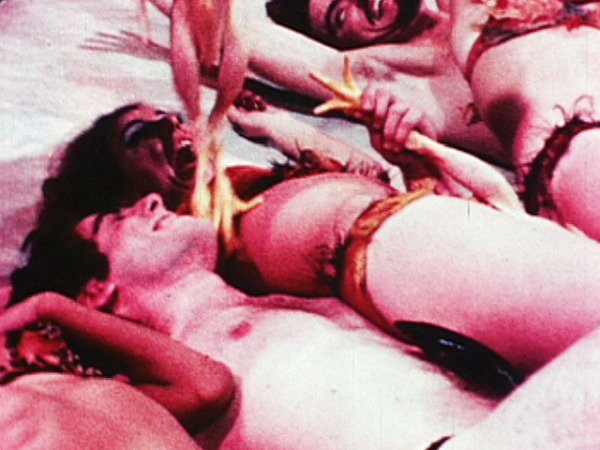Two exhibitions
dal 12/10/2012 al 23/11/2012
Segnalato da
12/10/2012
Two exhibitions
Institute of Modern Art - IMA, Brisbane
One of Carolee Schneemann most important and iconic works from this time was the 1963 group performance Meat Joy: it explored the way social dynamics change when cultural taboos and restrictions are lifted. Peter Cripps' work has been concerned with logics and technologies of display. He explores the relationships - both formal-phenomenological and conceptual-ideological - between objects and the spaces in which they are presented.

Carolee Schneemann
Meat Joy
American artist Carolee Schneemann is a legendary figure in the women's art movement. Throughout her career, she sought to liberate herself from oppressive artistic and social conventions and constraints, while using her body to express a potent female sexuality.
In 1962, she began a three-year collaboration with New York's Judson Dance Theatre, the avant-garde performance collective. One of her most important and iconic works from this time was the 1963 group performance Meat Joy. In it, eight scantily clad figures (men and women) crawl and roll about, playing with sausages, raw fish, raw poultry, wet paint, transparent plastic, ropes, scraps of paper, and one another, while grooving out to a pop-music soundtrack. Their interaction sometimes resembles the slithering courtship of slugs, other times a frat-house initiation rite. Schneemann described her Dionesian orgy-as-art as an 'erotic rite' and a 'celebration of flesh as material'.
A classic example of counterculture thinking, Meat Joy explored the way social dynamics change when cultural taboos and restrictions are lifted. And, as much as Schneemann is central to feminist art, Meat Joy did not fit into that category unequivocally. In the performance, gendered power games persisted as male participants threw women over their shoulders and proudly paraded around. Schneemann showed how removing boundaries can amplify existing power politics, rather than eliminate them.
Thanks to Electronic Arts Intermix, New York.
---
Peter Cripps
Endless Space
Melbourne artist Peter Cripps has been a key figure in Australian art since the 1970s. He emerged at a time when minimalism and conceptualism were challenging an older idea of art generally, and of sculpture specifically. As an expression of those challenges, his work has been concerned with logics and technologies of display. Cripps explores the relationships—both formal-phenomenological and conceptual-ideological—between objects and the spaces in which they are presented.
Our exhibition spans Cripps's career. The earliest works were produced in the late 1960s, while the latest works were made specially for the show. The show traces several ongoing strands of his inquiry. One strand is mirrors. The show includes examples of Cripps's mirror studies from the 1970s (which explore the spatial paradoxes mirrors produce) and the Public Project works that he has been making since the early 1990s (Tatlinesque towers mounted with convex surveillance mirrors). Another strand is the influence of landscape. Cripps's sculpture was informed by his childhood environment, particularly its distinctive coastal architecture (with its concrete-block bathing pavilions and World War II bunker remnants) and the Mordialloc timber yard (with its typography of drying kilns, timber stacks, and railway lines). This influence is apparent in the Above and Below Ground constructions he began making in 1968.
Alongside minimalism and conceptualism, museology has been a key influence. While working as an artist, Cripps has been employed as a curator, making institutional exhibitions of other artists' works. In the 1970s, he was an assistant curator at Melbourne's National Gallery of Victoria, and, from 1984 to 1986, he was Director of the IMA. Partly because of this, thinking about archives and museums, and their languages and technologies of display, underpins much of his work. Our show includes Shells of Past Activities, a personal museum composed of photos, texts, and state-library reading cards.
Peter Cripps teaches at RMIT, Melbourne. He is represented by Anna Schwartz Gallery, Melbourne and Sydney.
Image: Carolee Schneemann Meat Joy 1964–2010. Courtesy Electronic Arts Intermix, New York
Famous American photographer Gregory Crewdson to visit: Saturday 13 October at 2pm
Institute of Modern Art
at the Judith Wright Centre of Contemporary Arts
420 Brunswick Street / PO Box 2176
Fortitude Valley - Brisbane QLD 4006
Gallery Hours
Tuesday–Saturday 11am–5pm
Open Late Thursday until 8pm
We are closed to the public during exhibition changeovers, on public holidays, the full Easter weekend, and over the Christmas/New Year break.



